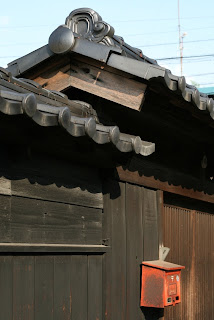Oi-juku
 Ando Hiroshige's locally famous woodblock print of Oi-juku from his "Sixty-nine Stations of the Kisokaido."
Ando Hiroshige's locally famous woodblock print of Oi-juku from his "Sixty-nine Stations of the Kisokaido." Click here for a color version, and here to see an extensive collection of his works, with explanations.
It's no touristy Magome or Tsumago these days, but my city was also a stop on the Nakasendo, mukashi mukashi. With all my free time these days, I took the camera out the other day to warm up the new lens and have some pictures from my own town.


 Detail of the roof of the entrance gate to Oi Honjin.
Detail of the roof of the entrance gate to Oi Honjin.Although the actual inn burned down in 1947 and the current honjin was subsequently rebuilt, the entrance gate to Oi Honjin survived. According to the sign in front, at around 400 hundred years old, it is said to be the most beautiful of all the honjin gates of the Nakasendo


 Protective barrier in front of a home.
Protective barrier in front of a home.Because of the thin walls and lack of glass in traditional homes, it was difficult not to be overheard. Often seen today in the geisha districts of Kyoto, these bamboo barriers served to keep potential eavesdroppers at a distance.
 Two Japans
Two JapansA traditional storehouse (kura) for family valuables or rice, and an example of Japan's love and dependence on konbinis.



 Kousatsuba
KousatsubaThe kousatsuba was, during the Edo period, an information station set up at each of the post towns along the road. Strategically located along the road, it prominently displayed the shogun's orders to the public.










0 Comments:
Post a Comment
<< Home